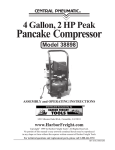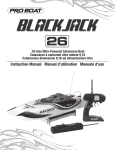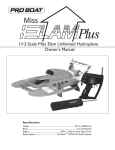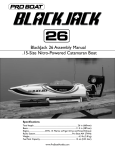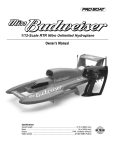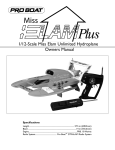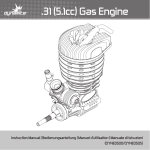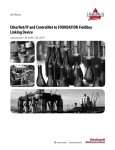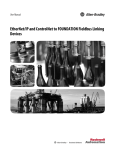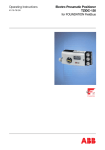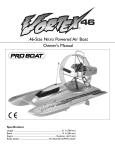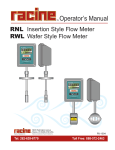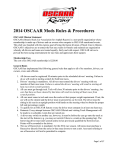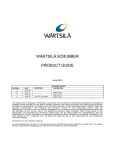Download Performance engines owners manual
Transcript
Care and Handling of fuel • Follow all directions and warnings on the fuel bottle. • It is very important to keep fuel containers capped tightly at all times. Some components in the fuel can evaporate very quickly or absorb moisture upsetting the performance qualities of the fuel. • Never store unused fuel in the fuel dispensing bottle. Immediately return fresh unused fuel back into your Performance Engines quart or gallon fuel bottle. • Never mix old fuel with fresh new fuel. Never mix Owners Manual different fuel brands together. INTRODUCTION • Always store the fuel in a cool dry location, off of concrete floors and away from any source of heat, Congratulations on your purchase of a Dynamite® ignition, flame or combustion. racing engine. Precisely manufactured and assembled, your Dynamite engine will provide you with troubleWarning! Model engine fuel is poisonous free performance if you carefully read and follow to humans and animals. these instructions. Drinking model fuels can cause blindness and death. Handle with utmost care and respect. Keep model fuels Using the Proper Equipment out of reach of children. Never leave your fuel where a FUEL child could have access to it. Using the proper fuel is critical in order to achieve GLOW PLUGS maximum engine performance, reliability, and longevity. A glow plug has been included and is ideal for breaking in You must use fuel that is specifically designed for model your new engine. In fact, during the break-in procedure, car/truck/buggy applications. Never use any type of model it is not uncommon to go through one or two glow plugs, airplane glow fuel! Use of model airplane fuel can damage as microscopic bits of metal (from the cylinder/piston your engine and immediately void any warranty. wearing in) bond themselves to the plug element causing For general use we recommend using Dynamite Blue glow plug failure. We recommend Dynamite glow plugs Thunder™ Race Formula fuel with 20% nitro. This fuel as the absolute best glow plugs for this engine. Dynamite provides the best combination of power, fuel economy and glow plugs have been designed to deliver an ideal balance engine life. Dynamite Blue Thunder fuels are vigorously of performance and longevity. tested, researched and formulated to deliver excellent We recommend the DYN2500 glow plug for engines up power as well as engine protection. to .15 cu in and the DYN2495 for engines that are .20 cu Dynamite Blue Thunder is the only fuel which is 100% in and larger. It is a good idea to keep at least a couple of certified for use in Dynamite engines. extra glow plugs in your pit box at all times. 1 AIR FILTERS All model car engines must use a properly oiled air filter to keep dirt out of the engine. Any dirt that enters the carburetor can immediately destroy your engine. We recommend DYN2612 as an excellent choice for a quality air cleaner for .12 and .15 engines and DYN2614 for .21 and larger engines. Clean and re-oil the air filter after each hour of running to prevent sucking dirt into the engine. If you intend to run your vehicle in extremely dusty conditions the air filter should be serviced after each 1/2 hour. STARTER BOX AND GLOW IGNITER Dynamite engines are equipped with either a pull start/ spin start system or may require the use of a starter box. For spin start engines we recommend the DYN5645 Spin Start Hand Held Starter. While we recommend using a spin starter or a starter box for the initial starts, starting the pull start/spin start equipped engine can be accomplished using the pull starter only as well. For the starter box version, we recommend using the DYN5610 Ready-Start Universal starter box in order to handle the high compression of the Dynamite engine. You will also need a glow plug igniter (glow driver) to light the glow plug. Use a high-quality rechargeable glow igniter such as the Dynamite metered glow driver (DYN1925). Make sure it is fully charged per the instructions. Engine BREAK-IN Dynamite racing engines are manufactured to exacting tolerances and require a special break-in procedure in order to accomplish the final precise fitting of the internal engine components. It is very important that you follow the break-in procedure as closely as possible in order to achieve the best performance and longest life from your Dynamite engine. Engine break-in will take between one and two hours. Dynamite engines are manufactured with an ABC piston/ sleeve construction. ABC stands for aluminum piston, and a brass sleeve that is chrome plated. This type of engine design relies on a very precise running fit between the piston and sleeve for proper cylinder sealing and is vital to achieving reliable long lasting engine performance. People have differing opinions on what is the proper procedure to break in a model engine. Old style break-in procedures, such as idling the engine at low operating temperatures on the bench for several tanks of fuel or simply running the engine with a very rich fuel mixture for the first 4 tanks of fuel, will not achieve the best results. Only use the Dynamite break-in procedure. Other break-in procedures could result in a weak, damaged, or otherwise poorly performing engine. The procedure outlined here was extensively tested and proven to yield better performing engines than other “common” break-in methods. Allow yourself plenty of time in order to properly breakin your engine. The engine break-in period will take a minimum of 5 tanks of fuel. Do not use the break-in time to impress your friends with your new engine. Patiently wait until the engine is fully broken in before attempting continued high-speed running. During break-in, your engine may appear to be malfunctioning with symptoms like stalling, unpredictable performance, and fouled glow plugs. These are simply the normal “break-in pains” engines sometimes go through. They will disappear once your engine is fully broken in. Carburetor Adjustments Break-in Procedures AND TIPS Break-in will be accomplished by accelerating, slowing, and accelerating again at different rates for the first 5 tanks of fuel. Once the engine begins to break in, the length and amount of the acceleration will progressively increase. Continued high-speed running is not acceptable during the first 5 tanks of fuel. Perform the initial break-in on a large, flat, paved surface. Smoothly apply all accelerating and decelerating action. Avoid rapid acceleration and decelerating as this could cause the engine to stall. • Special break-in fuels are not recommended. Break-in should be performed using the same fuel you plan to use daily. • Avoid breaking in the engine in extremely hot or cold conditions. • Avoid allowing the fuel tank to run completely empty. Low fuel levels cause the mixture to run too lean possibly resulting in a burned glow plug or higher than recommended engine temperature. • Do not break in the engine by simply idling it on a stand. This will not achieve the best results. • A glow plug has been included and is ideal for breaking in your new engine. During the break-in procedure it is not uncommon to go through one or two plugs as microscopic bits of metal (from the piston/sleeve wearing in) bond themselves to the plug element causing glow plug failure. Keep extra glow plugs handy. • Change or clean your air filter after the break-in procedure is complete. • Follow the instructions exactly for each of the first 5 tanks of fuel. • Never run your engine indoors. The exhaust fumes are very harmful so always run your model outdoors, in a well-ventilated area. 2 Your Dynamite engine comes equipped with one of a number of available carburetors. Engines such as the .12, .15, and .18 are equipped with either a 2-needle rotary or 2-needle slide valve carburetor. Engines .21 and larger are equipped with either a 2-needle or 3-needle slide valve carburetor. Below are illustrations of each. Please take a moment to review the pictures below in order to familiarize yourself with the various functions that apply to the particular carburetor that was supplied with your engine. Note: The carburetor’s initial startup fuel mixture settings have been preset at the factory. Do not change the settings. High-Speed Needle Idle Adjustment Lean Rich Fuel Inlet .21 and larger 2- and 3-needle slide valve carburetor Idle Adjustment High-Speed Needle High-Speed Needle Lean Lean Lean Increase Rich Rich Idle Adjustment Low-Speed Needle Fuel Inlet Decrease Fuel Inlet .12, .15 and .18 2-needle slide valve carburetor Rich .21 and larger 2- and 3-needle slide valve carburetor .12, .15 and .18 2-needle rotary carburetor Low-Speed Needle Increase Lean Idle Adjustment Lean Lean Idle Adjustment Low-Speed Needle Decrease Mid-Range Needle Rich .21 and larger 3-needle slide valve carburetor Rich Rich Low-Speed Needle .12, .15 and .18 2-needle rotary carburetor 3 .12, .15 and .18 2-needle slide valve carburetor Engines .21 or larger may also be equipped with a slide valve carburetor that includes three inserts of various diameters. These are sometimes referred to as “restrictors” or “venturies”. These carburetor inserts are used to alter the power curve of the engine along with fuel economy. The three diameters have the following effects. Small: Develops smooth linear power and is easier to control than a larger insert. Best suited for medium to low traction conditions on small to average size tracks. Also offers the best fuel mileage. Medium: Increased power for high traction, medium to large size tracks with a slight decrease in fuel mileage over the small insert. Large: Offers the most explosive power and acceleration with high-fuel consumption. Used for large and fast high-traction tracks. Starting Your Dynamite Engine for the First Time The first start of your engine is the most critical time of the engine’s life, dictating how well it will perform and maximizing its life expectancy. Before you start your Dynamite engine for the first time, make sure you have read all instructions and precautions in this manual. Pay close attention to the tank-by-tank break-in instructions in the next section, and make sure you have read and understood them before you run your engine. It is recommended but not totally necessary to use a heat gun to heat the engine to 160–180 degrees before you start the break-in process. Your engine must be at room temperature (70°F or 21° C) or above the first time you start it. If it’s cooler than room temperature outside, remove all fuel and keep your vehicle indoors until you’re ready to start it and then take it outside. If it’s colder than 45 degrees, special considerations should be made. We do not recommend running Dynamite engines at temperatures below 35 degrees. See the cold weather break-in tips section for more information. Factory Needle Settings If the engine is primed too long, it will flood with fuel and stop turning. Your carburetor is preset at the factory to give the correct Should the engine become difficult for your starter air-to-fuel ratio and idle speed for break-in. Do not box or hand held starter to turn over, the engine may adjust the carburetor unless you observe a poor running be flooded (hydro-locked).The presence of excess condition that requires correction. fuel between the cylinder head and piston will not Non-pull start and Pull/Spin Start engines: allow the piston to travel through its full range of For the non-pull start version engine, we recommend compression, effectively “hydro-locking” the engine. using the DYN5610 Ready-Start Universal starter box in Should this occur, remove the glow igniter from the plug. order to handle the high compression of the Dynamite Using a glow plug wrench (DYN2510), remove the glow engine. For spin start engines we recommend the plug and turn the model upside down and rotate the DYN5645 Spin Start Hand Held Starter. flywheel to clear out the excess fuel, reinstall the glow You may need to “blip” the throttle on the transmitter plug and start again. (applying throttle on/off) while trying to start the engine, Note: Your Dynamite engine doesn’t usually require as new engines are more difficult to start due to the tight priming. If you do need to prime your engine, watch piston/cylinder fit. the fuel line carefully to avoid flooding your engine. 1. Install the engine into your vehicle. Another common occurrence with new engines is for 2. Turn on the radio system. the piston to become stuck at the top of its travel in 3. Make sure the throttle trigger on the transmitter is in the sleeve. This occurrence is completely different from the idle (neutral) position and the carburetor is in the hydro-locking and is caused by the tight fit of the piston idle position also. and sleeve when the engine is new. In order to relieve 4. Connect the glow igniter to the engine. the stuck piston use a flat blade screwdriver through the 5. A. For non-pull start version engines, place the vehicle flywheel’s access hole in the chassis in order to pry the flywheel though its rotation. on a starter box and engage the starter. B. For spin start version engines, slide your hand This sticking issue should be completely eliminated by the under the strap of the starter so that your index finger break-in procedure. is on the switch at the bottom. Place the machined 7. Once fuel reaches the carburetor, the engine should end of the starter shaft into the matching hex socket quickly start and idle. in the backplate of the engine. Holding the starter 8. Disconnect the glow igniter from the model. securely, press on the switch button and the engine 9. Proceed with the engine break-in. should turn over and start up. 10.Do not rev your engine with no load (wheels off 6. Watch for fuel moving through the fuel line up to the ground). the carburetor. Pay close attention as the fuel moves very fast. If the fuel doesn’t move through the line within 5 seconds, prime the engine by briefly (one or two seconds) covering the exhaust outlet with your finger until the fuel is just visible moving through the carburetor fuel line. Watch carefully! 4 Pull start engines: 1. Install the engine into your vehicle. 2. Turn on the radio system. 3. Make sure the throttle trigger on the transmitter is in the idle (neutral) position and the carburetor is in the idle position also. 4. Connect the glow igniter to the engine. 5. Use short quick pulls to start the engine. When using a recoil starter, never pull the rope out its full length. Doing so may cause damage and recoil starter failure. Quick, short pulls of the recoil starter are the best technique to use. Never extend the starter rope more than 12 inches. Should the pull starter be extremely difficult to pull (will not extend out of the assembly), the engine may be flooded (hydro-locked). Excess fuel between the cylinder head and piston will not allow the piston to travel through its full range of compression, effectively “locking up” the engine. Should this occur, remove the glow igniter from the plug. Use a glow plug wrench (DYN2510) to remove the glow plug and turn the model upside down. Give the recoil starter a few short pulls to clear out the fuel, reinstall the glow plug and start again. Another common occurrence with new engines is for the piston to become stuck at the top of its travel in the sleeve. This occurrence is completely different from hydro-locking and is caused by the tight fit of the piston and sleeve when the engine is new. In order to relieve the stuck piston use a flat blade screwdriver through the flywheel’s access hole in order to pry the flywheel through its rotation. This sticking issue should be completely eliminated by the break-in procedure. If available, we recommend using a spin starter or starter box for the initial starts, even with a pull start equipped engine. You may need to “blip” the throttle on the transmitter (applying throttle on/off) while trying to start the engine, as new engines are more difficult to start due to the tight piston/cylinder fit. Tank-By-Tank Break-in Procedure: Tank #1 1. Once the engine starts the exhaust should emit lots of blue/white smoke, indicating that the engine is rich (a good thing during break-in). During the first tank of fuel, you may wish to set a higher than normal idle speed and/or leave the glow igniter attached in order to keep the engine from stalling. 2. Drive your vehicle on a large, flat, paved surface. Over a 2-second time span, gently pull the throttle trigger to 1/4 throttle and back again to idle. Accelerate and decelerate as smoothly as you can. 3. While accelerating, look for thick blue/white smoke from the exhaust. If there is no smoke, richen the high-speed fuel mixture 2 hours by turning the needle counterclockwise. Imagine the slot in the needle is like the hour hand on a clock. Adjust it as though you were moving the hour hand from one hour to the previous one. 4. Regularly check the fuel level while running. When the fuel tank is nearly empty, shut off the engine by touching the flywheel with a tool handle or small block of wood. Do this when the engine is at idle speed only. 5. Rotate the flywheel so that the piston is at bottom dead center (BDC). BDC can be found by rolling the engine over by the flywheel with your finger into the area of rotation that is “free” and without any drag. Let the engine cool for 15 minutes. Tank #2 1. Drive your vehicle on a large, flat, paved surface. Over a 2-second time span gently pull the throttle trigger to 1/2 throttle and back again to idle. Accelerate and decelerate as smoothly as you can. 5 2. Regularly check the fuel level while running. When the fuel tank is nearly empty, shut off the engine by touching the flywheel with a tool handle or small block of wood. Do this when the engine is at idle speed only. 3. Rotate the flywheel so that the piston is at bottom dead center (BDC). Let the engine cool for 15 minutes. Tank #3 1. Drive your vehicle on a large, flat, paved surface. Over a 3-second time span gently pull the throttle trigger to 1/2 throttle and back again to idle. Accelerate and decelerate as smoothly as you can. 2. As the engine breaks in, the idle speed may increase and cause your vehicle to try to creep forward when stopped. If this begins to occur, reduce the idle speed by turning the idle adjustment on the carburetor counterclockwise. 3. Regularly check the fuel level while running. When the fuel tank is nearly empty, shut off the engine by touching the flywheel with a tool handle or small block of wood. Do this when the engine is at idle speed only. 4. Rotate the flywheel so that the piston is at bottom dead center (BDC). Let the engine cool for 15 minutes. Tank #4 1. Drive your vehicle on a large, flat, paved surface. Over a 3-second time span gently pull the throttle trigger to 3/4 throttle and back again to idle. Accelerate and decelerate as smoothly as you can. 2. Regularly check the fuel level while running. When the fuel tank is nearly empty, shut off the engine by touching the flywheel with a tool handle or small block of wood. Do this when the engine is at idle speed only. 3. Rotate the flywheel so that the piston is at bottom dead center (BDC). Let the engine cool for 15 minutes. Tank #5 • Once the engine is running, it is important to keep the temperature of the engine up around 200 to 1. Drive your vehicle on a large, flat, paved surface. Over 215 degrees during break-in. In weather below 45 a 3-second time span gently pull the throttle trigger degrees, the engine will tend to run at lower than to full throttle and back again to idle. Accelerate and recommended temperatures of between 140 to 175 decelerate as smoothly as you can. degrees (at proper break-in mixture settings). Do not 2. Regularly check the fuel level while running. When lean the fuel mixture to increase engine temperature the fuel tank is nearly empty, shut off the engine by as this will decrease the available lubrication and touching the flywheel with a tool handle or small cause your piston/sleeve to wear prematurely. block of wood. From the fifth tank on, you will not • If needed wrap the cooling head with aluminum need to let the engine cool between tanks. However foil, paper towel, clean rag, or sock in order to when shutting down the engine at any time, rotate block some of the cooling airflow and help keep the the flywheel so that the piston is at bottom dead engine running around the recommended 200 to center (BDC). 215 break-in temp. Tank #6 The engine can actually run too hot if too much of 1. Clean and reoil your air filter before you proceed. the cooling airflow is blocked. Make sure that you During the sixth tank of fuel, you can run your vehicle monitor the engine’s temp closely for the first couple on smooth flat surfaces and off-road dirt as well. of tanks until you get the correct amount of cover for The engine can now begin to be tuned for general the cooling head which will depend on your current performance use. weather conditions. Adjust the cover up or down in order to expose more Cold Weather Break-in Tips or fewer cooling fins to regulate engine operating During the break-in process, the piston and sleeve wear temperature. into each other to form a precise fit. The engine needs to heat up to a temperature of around 200 to 215 degrees to • If you do not have a temperature probe, a drop of water on the cooling head (down around the glow relieve most of the mechanical stresses that the piston/ plug area) should slowly sizzle for about 5 to 10 sleeve/rod must endure during initial break-in. A precise seconds at around 200 to 210 degrees. If the water fit between these components is critical for proper sizzles for only a couple of seconds, the engine is compression, and optimum performance. If the engine likely over 220 degrees, and needs to be cooled down. runs too cold during break-in, the piston and sleeve will if water takes a long time or does not evaporate at all, not expand to their appropriate sizes for break-in, and this it means that the engine is running too cool. can lead to premature wear of these components. • In cold weather conditions it is recommended to use a • It is not recommended that you operate your engine when ambient temperatures are below 35 degrees heat gun to heat the engine to 160-180 degrees before Fahrenheit. If you attempt to run your vehicle below you start each tank of the break-in process. 35 degrees, your engine may become very difficult to start and tune. At temperatures below freezing, nitro fuel can begin to gel causing tuning and erratic running issues along with being harmful to the engine. 6 TUNING YOUR DYNAMITE RACING ENGINE A nitro engine’s performance depends on the fuel mixture. Turning the mixture needles clockwise will lean the fuel mixture and turning the mixture needles counterclockwise will richen it. Leaning the fuel mixture will increase engine power up to the point that the engine begins to starve for fuel and begins to overheat. An engine should never be run too lean; doing so severely shortens the life of the engine. When an engine is too lean, it will run very strong immediately after being started but will soon begin to sag and hesitate or stall when accelerating. The best way to tune an engine is by using an infrared temperature gauge, but you can use water to check the head temperature also. Tuning the High-Speed Needle To obtain the correct high-speed needle setting, start the engine and drive your vehicle around for a minute or two. Make several high-speed passes at full throttle in order to clear out the engine. Place a drop of water on the cylinder head. If the water sizzles away (evaporates immediately), the needle setting is too lean. A correct needle setting will result in the water evaporating after 3-5 seconds. If the water does not evaporate, chances are good that the needle setting is too rich. Lean the needle 1 hour (imagine the slot in the needle is the hour hand on a clock and adjust it as though you were moving the hour hand from one hour to the next or previous one) and run the engine again, adjusting the needle setting to get the desired evaporation time. Check the temperature each time you change the needle mixture. Do not let the engine overheat, as this will damage the engine. Tuning the Low-Speed Needle Idle Speed Adjustment The low-speed needle (also referred to as the idle mixture or idle needle) should be set after you’re satisfied with the high-speed needle setting. After achieving the proper operating temperature, make a couple of high-speed passes and then reduce the engine throttle to the idle position. Pinch the fuel line with your fingers close to the carb fuel inlet nipple. If the engine dies immediately, the low-speed needle is set too lean. If the rpm’s increase dramatically, the setting is too rich. The ideal setting results in the rpm’s increasing just a slight amount after pinching the fuel line. The last setting to be made is the idle speed. Remember, this adjustment should be made while the engine is running at normal operating temperature. 1. Make sure the throttle trim is set so that the carburetor is fully closed against the idle speed screw when the trigger is in the neutral position. The best way to assure that this setting is correct is by applying the brakes after several high-speed runs. After the vehicle has stopped, release the trigger to the neural position, the engine should not pick up rpm’s. When the brakes are reapplied the rpm’s should not drop. When the throttle trim is set correctly you should have to apply a slight amount of forward throttle before the rpm’s begin to rise from idle. This will ensure that the throttle slide is resting against the idle adjustment screw. 2. Turn the idle speed screw counterclockwise to reduce the idle speed, or clockwise to increase it. When there is a need to increase the idle speed, slightly open the throttle position while doing so in order to keep the idle screw from damaging the carburetor slide. Ideally, the engine should idle just fast enough to be reliable. Avoid an idle that is set too high, as it will cause the clutch mechanism to overheat and fail. Mid-Range Needle Adjustment The mid-range adjustment screw adjusts the air/fuel mixture at half throttle and can dramatically affect midrange throttle response. The factory setting will provide a slightly rich mid-range. For a crisper leaner mid-range, desirable on high traction tracks where maximum acceleration is needed, turn the mid-range screw out (counterclockwise) 1 full turn. To soften the mid-range response (richer), turn the mid-range screw clockwise 1 full turn for a softer feel during acceleration, best suited for low traction conditions. Note: The mid-range adjustment screw and low-speed needle work in unison. Any time the mid-range adjustment screw is adjusted it will be necessary to readjust the low-speed needle. When turning the mid-range screw in (clockwise), the low-speed needle will need to be backed out (counterclockwise). When the mid-range screw is backed out (counterclockwise), the low-speed needle will need to be adjusted inward (clockwise). Fuel Mixture Adjustment Chart The following chart provides general guidelines on how weather conditions and altitude affect air density when they move higher or lower than your baseline setting. IFISCreates an airRequired Tuning density that isAdjustment Temperature Higher Less Dense Leaner Lower More Dense Richer Humidity Higher Lower Less Dense More Dense Leaner Richer Pressure Higher Lower More Dense Less Dense Richer Leaner Altitude Higher Lower Less Dense More Dense Leaner Richer Nitro % Higher Lower N/A N/A Richer Leaner Tuning Engines by Temperature Do not rely on a temp gauge alone to tune your engine as there is NO optimal temperature that will deliver the best tune on any given day. Factors such as track conditions, Daily changes in temperature and barometric pressure may require you to adjust your carburetors needles. Also driving style, atmospheric conditions, and gauge accuracy will affect operating temperatures if you run your vehicle at a new location at a different Tune the engine by paying very close attention to how altitude, some carburetor adjustment may be needed. it responds to changes in fuel mixture (more smoke/ When the weather is colder and the air density is higher, less smoke, fast/sluggish, reliable/stalling, smooth you may need to richen the fuel mixture. sound/ muffled sound, etc). Remember to make small Conversely when the weather is warmer and the air adjustments of 1 hour at a time. Imagine the slot in density is lower, you may need to lean the fuel mixture. Remember to make small adjustments of 1 hour at a time. the needle is like the hour hand on a clock. Adjust it as though you were moving the hour hand from one hour Imagine the slot in the needle is like the hour hand on a clock. Adjust it as though you were moving the hour hand to the next or previous one. Once the engine is tuned for acceptable performance, then observe the temperature. from one hour to the next or previous one. Fine-Tuning the Carburetor 7 A temperature gauge should only be used as a tuning aid by giving you a relative indication of how your adjustments are affecting the engine and to help prevent you from reaching higher than recommended engine operating temperatures. As you lean the fuel mixture, the engine performance will increase along with the temperature. If you continue to lean the fuel mixture and the temperature increases but the engine performance does not change, then you have exceeded the maximum safe lean setting. In general, try to keep your engine from exceeding 270°F when measured at the glow plug. Most properly and fully broken in engines operate well at temperatures of 200 to 265°F depending on track conditions, driving style, atmospheric conditions, and gauge accuracy. FACTORY NEEDLE SETTINGS If at any point you find yourself “lost” as far as tuning goes, going back to the factory carburetor settings should allow you to get right back on track. Following is a listing of available carburetors and their factory preset needle settings. .12, .15, .18 2-needle slide valve carburetor: High-Speed Needle: 2 turns out (counterclockwise) from closed. Low-Speed Needle: 2 turns out (counterclockwise) from closed. .12, .15, .18 2-needle rotary carburetor: High-Speed Needle: 2 turns out (counterclockwise) from closed. Low-Speed Needle: 2 turns out (counterclockwise) from closed. When checking the adjustment of the low-speed needle, it is crucial that the throttle slide is closed completely when turning the needle and that you do not over-tighten the needle. Use a Dynamite 3-IN-1 engine-tuning screwdriver (DYN3048) to make this job easier. When you feel resistance in the needle, immediately stop turning and begin turning the needles counterclockwise, counting the number of turns from “closed”. .21 and larger 2-needle slide valve carburetor: High-Speed Needle: 31/2 turns out (counterclockwise) from closed. Low-Speed Needle: 2 turns out (counterclockwise) from closed. .21 and larger 3-needle slide valve carburetor: High-Speed Needle: 31/2 turns out (counterclockwise) from closed. Low-Speed Needle: 2 turns out (counterclockwise) from closed. Mid-Range Needle: Screw should be just slightly in from flush with the face of the carburetor. 8 Troubleshooting Guide Problem Engine won’t start: Possible Cause/Solution · Clogged fuel line · Bad or improper glow plug · Glow igniter not charged Engine starts, and then dies: · Engine flooded · Pressure line blocked or disconnected · Bad or improper glow plug Engine starts and runs for 1/2 tank and then quits · High-speed needle too lean · Hole or tear in fuel line · Defective fuel tank · Bad or improper glow plug · Idle speed set too low · Overheated engine (too lean) · Improper needle settings Protecting Your Investment Warranty Period Exclusive Warranty- Horizon Hobby, Inc., (Horizon) warranties that the Products purchased (the “Product”) After-run maintenance must be performed in order to keep will be free from defects in materials and workmanship at your engine in proper operating condition. the date of purchase by the Purchaser. After each day of running, it’s critical to use a highLimited Warranty quality after-run oil to protect the internals of the engine and help prevent corrosion. The methanol used (a) This warranty is limited to the original Purchaser in the fuel attracts moisture that can cause corrosion (“Purchaser”) and is not transferable. REPAIR OR (particularly in the ball bearings). REPLACEMENT AS PROVIDED UNDER THIS WARRANTY IS THE EXCLUSIVE REMEDY OF THE PURCHASER. This Follow these steps after running your engine: warranty covers only those Products purchased from an 1. Empty all fuel from the tank. authorized Horizon dealer. Third party transactions are not 2. Start and run the engine until completely out of fuel. covered by this warranty. Proof of purchase is required 3. Carefully remove the air filter. Avoid allowing any for warranty claims. Further, Horizon reserves the right dirt or debris to enter the carburetor. Add 5 to 6 to change or modify this warranty without notice and drops of a quality after-run oil into the carburetor. disclaims all other warranties, express or implied. Turn the engine over a few times to distribute the oil (b) Limitations- HORIZON MAKES NO WARRANTY OR throughout the engine. REPRESENTATION, EXPRESS OR IMPLIED, ABOUT 4. Clean and inspect the engine, air cleaner and fuel system. NON-INFRINGEMENT, MERCHANTABILITY OR FITNESS Never run your engine without a properly cleaned and FOR A PARTICULAR PURPOSE OF THE PRODUCT. THE oiled air filter. If you happen to lose an air filter while PURCHASER ACKNOWLEDGES THAT THEY ALONE HAVE running your vehicle stop immediately! Clean, reoil and DETERMINED THAT THE PRODUCT WILL SUITABLY reinstall the air filter before continuing. MEET THE REQUIREMENTS OF THE PURCHASER’S A throttle return mechanism is recommended. This can INTENDED USE. be as simple as a rubber band on the throttle linkage. (c) Purchaser Remedy- Horizon’s sole obligation This will prevent high-rpm engine runaways in the case of hereunder shall be that Horizon will, at its option, (i) radio or receiver pack malfunction. The Dynamite throttle repair or (ii) replace, any Product determined by Horizon return spring kit (DYN6640) is highly recommended for to be defective. In the event of a defect, these are the .21 and larger engines. Purchaser’s exclusive remedies. Horizon reserves the A few minutes spent before and after each time you right to inspect any and all equipment involved in a run your model will allow you to enjoy it for a long warranty claim. Repair or replacement decisions are time to come. at the sole discretion of Horizon. This warranty does not cover cosmetic damage or damage due to acts of God, accident, misuse, abuse, negligence, commercial use, or modification of or to any part of the Product. This warranty does not cover damage due to improper installation, operation, maintenance, or attempted repair by anyone other than Horizon. AFTER-RUN MAINTENANCE 9 Return of any goods by Purchaser must be approved in writing by Horizon before shipment. Damage Limits HORIZON SHALL NOT BE LIABLE FOR SPECIAL, INDIRECT OR CONSEQUENTIAL DAMAGES, LOSS OF PROFITS OR PRODUCTION OR COMMERCIAL LOSS IN ANY WAY CONNECTED WITH THE PRODUCT, WHETHER SUCH CLAIM IS BASED IN CONTRACT, WARRANTY, NEGLIGENCE, OR STRICT LIABILITY. Further, in no event shall the liability of Horizon exceed the individual price of the Product on which liability is asserted. As Horizon has no control over use, setup, final assembly, modification or misuse, no liability shall be assumed nor accepted for any resulting damage or injury. By the act of use, setup or assembly, the user accepts all resulting liability. If you as the Purchaser or user are not prepared to accept the liability associated with the use of this Product, you are advised to return this Product immediately in new and unused condition to the place of purchase. Law: These Terms are governed by Illinois law (without regard to conflict of law principals). Safety Precautions This is a sophisticated hobby Product and not a toy. It must be operated with caution and common sense and requires some basic mechanical ability. Failure to operate this Product in a safe and responsible manner could result in injury or damage to the Product or other property. This Product is not intended for use by children without direct adult supervision. The Product manual contains instructions for safety, operation and maintenance. It is essential to read and follow all the instructions and warnings in the manual, prior to assembly, setup or use, in order to operate correctly and avoid damage or injury. Questions, Assistance, and Repairs Non-Warranty Repairs Your local hobby store and/or place of purchase cannot provide warranty support or repair. Once assembly, setup or use of the Product has been started, you must contact Horizon directly. This will enable Horizon to better answer your questions and service you in the event that you may need any assistance. For questions or assistance, please direct your email to productsupport@horizonhobby. com, or call 877.504.0233 toll free to speak to a service technician. Should your repair not be covered by warranty the repair will be completed and payment will be required without notification or estimate of the expense unless the expense exceeds 50% of the retail purchase cost. By submitting the item for repair you are agreeing to payment of the repair without notification. Repair estimates are available upon request. You must include this request with your repair. Non-warranty repair estimates will be billed a minimum of 1/2 hour of labor. In addition you will be billed for return freight. Please advise us of your preferred method of payment. Horizon accepts money orders and cashiers checks, as well as Visa, MasterCard, American Express, and Discover cards. If you choose to pay by credit card, please include your credit card number and expiration date. Any repair left unpaid or unclaimed after 90 days will be considered abandoned and will be disposed of accordingly. Please note: non-warranty repair is only available on electronics and model engines. Inspection or Repairs If this Product needs to be inspected or repaired, please call for a Return Merchandise Authorization (RMA). Pack the Product securely using a shipping carton. Please note that original boxes may be included, but are not designed to withstand the rigors of shipping without additional protection. Ship via a carrier that provides tracking and insurance for lost or damaged parcels, as Horizon is not responsible for merchandise until it arrives and is accepted at our facility. A Service Repair Request is available at www.horizonhobby.com on the “Support” tab. If you do not have internet access, please include a letter with your complete name, street address, email address and phone number where you can be reached during business days, your RMA number, a list of the included items, method of payment for any non-warranty expenses and a brief summary of the problem. Your original sales receipt must also be included for warranty consideration. Be sure your name, address, and RMA number are clearly written on the outside of the shipping carton. Warranty Inspection and Repairs To receive warranty service, you must include your original sales receipt verifying the proof-of-purchase date. Provided warranty conditions have been met, your Product will be repaired or replaced free of charge. Repair or replacement decisions are at the sole discretion of Horizon Hobby. United States Electronics and engines requiring inspection or repair should be shipped to the following address: Horizon Service Center 4105 Fieldstone Road Champaign, Illinois 61822 All other Products requiring warranty inspection or repair should be shipped to the following address: Horizon Product Support 4105 Fieldstone Road Champaign, Illinois 61822 Please call 877-504-0233 or e-mail us at [email protected] with any questions or concerns regarding this product or warranty. United Kingdom Electronics and engines requiring inspection or repair should be shipped to the following address: Horizon Hobby UK Units 1-4 Ployters Rd Staple Tye Harlow, Essex CM18 7NS United Kingdom Please call +44 (0) 1279 641 097 or e-mail us at sales@ horizonhobby.co.uk with any questions or concerns regarding this product or warranty. Germany Electronics and engines requiring inspection or repair should be shipped to the following address: Horizon Technischer Service Hamburger Strasse 10 25335 Elmshorn Germany Please call +49 4121 46199 66 or e-mail us at service@ horizonhobby.de with any questions or concerns regarding this product or warranty. © 2009 Horizon Hobby, Inc. Dynamite engines are manufactured in Taiwan and distributed worldwide by: Horizon Hobby, Inc. 4105 Fieldstone Rd. Champaign, IL 61822 www.horizonhobby.com 10 Printed 05/09 15464.1










